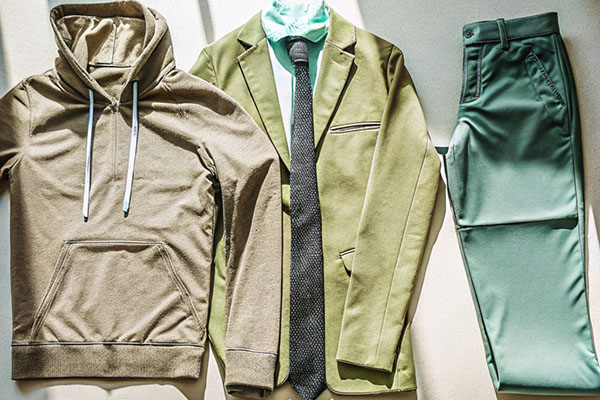Clothing serves many purposes beyond just covering our bodies. It reflects cultural values, provides functionality, and allows us to express personal style. While the fashion industry offers countless styles and categories, clothing can be broadly classified into three main types based on purpose: casual wear1, formal wear2, and activewear3.
The three main types of clothes are casual wear1, designed for comfort and everyday use; formal wear2, intended for professional or special occasions; and activewear3, tailored for physical activity and sports.
Let’s explore each category in depth, what defines them, and how they fit into our daily lives.

What is casual wear?
Casual wear refers to clothing designed for comfort and practicality. It’s the most versatile and widely used type of clothing, suitable for a range of informal settings such as running errands, meeting friends, or relaxing at home.
Casual wear1 is defined by its relaxed fit, breathable fabrics, and emphasis on comfort. It includes staples like jeans, T-shirts, hoodies, and sneakers.
Key characteristics of casual wear
- Comfort-first designs: Loose fits, stretchable fabrics, and breathable materials like cotton and jersey dominate casual wear.
- Simplicity: Minimalistic designs with little to no embellishment.
- Versatility: Easily mixed and matched to create different looks.
Examples of casual clothing
| Item | Description |
|---|---|
| T-Shirts | Lightweight and easy to style. |
| Jeans | Durable and iconic for everyday wear. |
| Hoodies | Perfect for layering and casual outings. |
| Sneakers | Functional and comfortable footwear. |
Pro Tip: Neutral-colored casual wear, like black, white, or gray T-shirts, makes it easier to create versatile outfits.

What is formal wear?
Formal wear refers to clothing designed for professional or special occasions. It emphasizes elegance, structure, and adherence to specific dress codes.
Formal wear2 is defined by its polished appearance, use of structured fabrics, and often stricter styling guidelines. It includes suits, dresses, blazers, and dress shoes.
Key characteristics of formal wear
- Sophisticated fabrics: Materials like wool, silk, and satin are common for formal clothing.
- Structured tailoring: Precision tailoring ensures a clean, professional fit.
- Neutral tones or dress code adherence: Formal clothing typically sticks to classic colors and dress codes4.
Examples of formal clothing
| Item | Description |
|---|---|
| Suits | Essential for business or formal events. |
| Blazers | Versatile for semi-formal occasions. |
| Evening Gowns | Long, flowing dresses for black-tie events. |
| Dress Shoes | Polished and elegant footwear. |
Common uses of formal wear
- Workplace attire: Business suits, pencil skirts, and blouses for office settings.
- Events: Weddings, galas, or award ceremonies that require refined clothing.
Pro Tip: Investing in timeless formal pieces like a tailored blazer or black dress can provide versatility for multiple occasions.

What is activewear?
Activewear, also known as sportswear, is clothing specifically designed for physical activities. With its focus on flexibility and performance, activewear has gained popularity not just for workouts but also as a casual fashion statement.
Activewear3 is defined by its lightweight, moisture-wicking materials, and stretchable designs. It includes leggings, sports bras, sweatpants, and running shoes.
Key characteristics of activewear
- Technical fabrics: Materials like polyester, spandex, and nylon ensure durability and flexibility.
- Moisture management: Wicks sweat away, keeping the wearer cool and dry.
- Ergonomic design: Seamless stitching, stretch, and support for enhanced movement.
Examples of activewear
| Item | Description |
|---|---|
| Leggings | Stretchable and supportive for yoga or running. |
| Sports Bras | Provides support during high-impact activities. |
| Sweatpants | Comfortable and casual for light workouts or lounging. |
| Running Shoes | Designed for comfort and durability during activity. |
Activewear trends: Athleisure
Athleisure5 is a blend of activewear and casual wear. Leggings paired with oversized T-shirts or sneakers worn with casual dresses have become popular everyday looks.
How do these clothing types fit into everyday life?
Each type of clothing serves distinct purposes, but they often overlap in our daily lives. A clear understanding of these categories can help build a well-rounded wardrobe.
| Type | Primary Use | Secondary Use |
|---|---|---|
| Casual Wear | Everyday comfort and versatility. | Traveling or relaxed events. |
| Formal Wear | Work, weddings, or formal occasions. | Dressing up for semi-formal events. |
| Activewear | Exercise and sports activities. | Athleisure for casual outings. |
Why understanding clothing types matters
Knowing these three main types of clothing helps you make smarter purchasing decisions and create a wardrobe that fits your lifestyle. It ensures that your clothes are not only functional but also stylish and appropriate for various occasions.
Tips for building a balanced wardrobe
- Invest in staples: Neutral T-shirts, tailored blazers, and quality leggings are essential.
- Match the occasion: Always consider the event or activity to choose the right clothing type.
- Mix and match: Blend casual wear with formal elements or activewear pieces for versatile outfits.
Conclusion
The three main types of clothing—casual wear1, formal wear2, and activewear3—serve different purposes and reflect various aspects of our lifestyles. Casual wear is all about comfort and versatility, formal wear offers elegance and professionalism, while activewear combines functionality and style. By understanding these categories, you can make informed choices and build a wardrobe that meets your daily needs while reflecting your personal style.













